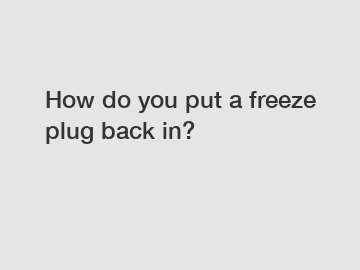Feb. 02, 2024
Mechanical Parts & Fabrication Services
Link to NNK
How do you put a freeze plug back in? A step-by-step guide to tackle this common engine issue.
Are you facing an issue with your vehicle's freeze plug? Don't worry! We have you covered with a comprehensive guide on how to put a freeze plug back in. A freeze plug, also known as an expansion plug, is designed to prevent coolant from leaking out of the engine block. Over time, these plugs can become corroded or damaged, leading to coolant leaks. In this article, we will walk you through the process of replacing a freeze plug, step-by-step, ensuring a smooth and successful repair.

1. Gather the necessary tools and materials.
Before you begin the repair, make sure you have all the required tools and materials within reach. You will need a socket set, pliers, a rubber mallet, a pry bar, a freeze plug kit (including the appropriate freeze plugs), a hammer, and a high-temperature sealant. It's important to ensure the freeze plugs you purchase match the specifications and size requirements of your engine.
2. Drain the coolant.
The first step in replacing a freeze plug is to drain the coolant from the engine. Locate the drain valve or petcock at the bottom of the radiator and open it to allow the coolant to flow out into a suitable container. Once drained, safely dispose of the coolant as it is hazardous to the environment. Be cautious, as the coolant may still be hot.
3. Access the freeze plug.
Depending on the location of the freeze plug, you may need to remove certain components to gain access to it. In some cases, it may be necessary to remove the exhaust manifold, motor mount, or other nearby parts. Follow the manufacturer's guidelines for your specific vehicle to ensure a proper and safe disassembly.
4. Remove the damaged freeze plug.
Using a pry bar or pliers, carefully remove the damaged freeze plug from the engine block. Apply gentle pressure and work around the edges until it comes loose. If the freeze plug is stubborn, you may need to use a hammer and a punch tool to tap it out from the backside. Take caution not to damage the surrounding area during this process.
5. Clean the freeze plug cavity.
Once the old freeze plug has been removed, thoroughly clean the cavity to ensure a proper fit for the replacement plug. Use a wire brush or sandpaper to remove any debris or corrosion from the surface. Ensure the cavity is smooth and free from any remaining pieces of the old freeze plug.
6. Install the new freeze plug.
Apply a thin layer of high-temperature sealant around the edges of the replacement freeze plug. This will help create a watertight seal and prevent future leaks. Gently tap the new freeze plug into place using a rubber mallet or a hammer and a wooden block. Ensure it sits flush with the engine block's surface.
7. Reassemble the components.
After the new freeze plug is securely in place, reassemble any components that were removed earlier to access it. Follow the reverse order of the disassembly process, referring to the manufacturer's guidelines for torque specifications and proper attachments. Take care not to overtighten bolts or damage any surrounding parts.
8. Refill the coolant.
With all components back in place, it's time to refill the engine with coolant. Refer to your vehicle's manual for the proper coolant type and mixing instructions. Slowly pour the coolant into the radiator until it reaches the recommended level. Check for any leaks before replacing the radiator cap.
In conclusion, putting a freeze plug back in is a relatively straightforward process that can be tackled by any enthusiastic DIYer. By following these step-by-step instructions, you can successfully replace a damaged freeze plug and prevent coolant leaks. Remember to gather the necessary tools, drain the coolant, access the freeze plug, remove the damaged plug, clean the cavity, install the new plug, reassemble the components, and refill the coolant. With patience and careful execution, your engine will be back to running smoothly and leak-free.
Want more information on o ring kit box sizes? Feel free to contact us.
Previous: What is shaft cross joint?
Next: Maximizing Efficiency: Unveiling Stacked Hydraulic Control
If you are interested in sending in a Guest Blogger Submission,welcome to write for us!
All Comments ( 0 )